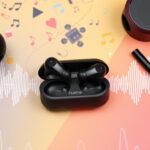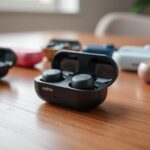Did you know the Philips On-Ear Solar-Powered Headphones can recharge with solar power? They’re a greener choice for music fans and last up to 80 hours on a full charge. This tech is a big leap forward for eco-friendly headphones and music tech.
The headphones are perfect for those who care about the planet. They use Powerfoyle solar cells to charge up indoors or outdoors. This is a big part of what makes them eco-friendly1.
These headphones show how tech can be both new and green. They’re ideal for anyone wanting eco-friendly headphones. By using solar power, they cut down on traditional charging needs.
- Introduction to Solar-Powered Headphones
- Features of Philips On-Ear Solar-Powered Headphones
- How Solar Charging Works
- Environmental Impact of Solar-Powered Headphones
- User Experience and Comfort
- Comparison with Traditional Headphones
- Connectivity Options
- Maintenance Tips for Solar-Powered Headphones
- Customer Reviews and Testimonials
- Where to Buy Philips Solar-Powered Headphones
- Conclusion and Future of Sustainable Audio
- FAQ
- Source Links
Key Takeaways
- The Philips On-Ear Solar-Powered Headphones offer a battery life of up to 80 hours when fully charged1.
- The headphones feature Powerfoyle solar cell technology that allows them to recharge using both indoor artificial light and outdoor sunlight1.
- The Philips On-Ear Solar-Powered Headphones are designed for the eco-conscious music lover, making them a great option for those looking for on-ear solar-powered Philips headphones and sustainable audio technology.
- The headphones reduce the need for traditional charging methods, making them a more sustainable option.
- The Philips On-Ear Solar-Powered Headphones are a great example of how technology can be both innovative and sustainable, aligning with the principles of sustainable audio technology and on-ear solar-powered Philips headphones.
Introduction to Solar-Powered Headphones
The trend of making audio tech more sustainable is growing fast. People want products that are good for the planet and sound great. Solar-powered headphones are a big step in this direction. They use the sun’s energy, which is clean and cuts down on carbon emissions.
These headphones also last longer and cost less to use. This is because they don’t need batteries that need to be replaced or charged often.
Using solar power in headphones has many perks. It’s good for the environment, saves money, and lets you charge them anywhere. For instance, the Urbanista Los Angeles headphones use special solar cells. These cells turn any light into energy, so you can listen for hours without stopping3.
The Philips A6219 GO headphones can play music for up to 80 hours. They use the same solar-cell tech2.
The Rise of Sustainability in Audio Technology
The audio tech world is changing fast. More brands are using green materials and energy sources. This change is because people want products that are both top-notch and kind to the planet.
Benefits of Solar Power in Headphones
Solar-powered headphones offer many advantages. Here are a few:
- They’re better for the environment
- They save you money on energy
- They last longer without needing a battery change
- They’re easy to charge anywhere
Features of Philips On-Ear Solar-Powered Headphones
The Philips On-Ear Solar-Powered Headphones offer a comfy and top-notch listening experience. They are light, making them ideal for everyday use. This means you can enjoy your tunes without feeling heavy. The sound is clear and sharp, thanks to the 40 mm neodymium drivers4.
These headphones stand out because of their long battery life. They can play for up to 80 hours, thanks to solar charging. They can even charge under both sunlight and electrical light. This makes them perfect for those who care about the environment. The Philips wireless earphones show how tech can be both new and green.
Some of the key features of the Philips On-Ear Solar-Powered Headphones include:
- Long battery life of up to 80 hours
- Solar charging technology using Powerfoyle™
- Exceptional sound quality with 40 mm neodymium drivers
- Lightweight design for comfortable wear
These solar-charging headphones are perfect for those who love music and the planet. They offer long battery life and amazing sound. The Philips On-Ear Solar-Powered Headphones are a top pick for a green and reliable listening experience5.
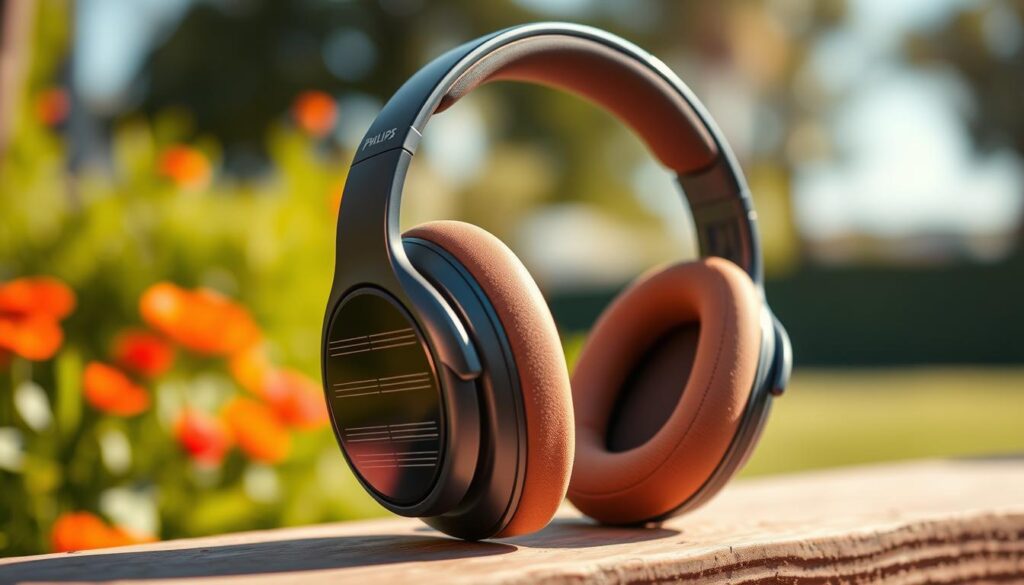
How Solar Charging Works
Solar charging technology turns sunlight into electrical energy. This is key for green tech in audio gear. The Philips On-Ear Solar-Powered Headphones can catch light indoors and outdoors. They work well in many places.
This tech is a big step towards using less traditional power. It’s good for the planet.
It’s important to know how solar cells work. They can charge even when it’s not very bright. The Powerfoyle tech also gives almost constant battery life6.
Understanding Solar Cells
Solar cells are the core of solar charging. They turn sunlight into electricity. The quality of these cells affects how well they work7.
But, new tech has made solar cells better. Now, they’re a solid power source for green audio tech.
Charging Efficiency in Different Environments
The efficiency of solar headphones changes with the setting. For example, the Philips A6219 can last up to 80 hours on solar power6. This is great for those who listen to music a lot.
Also, these headphones are made from recycled materials. This cuts down on waste and helps the environment7.
Environmental Impact of Solar-Powered Headphones
Solar-powered headphones, like the Philips On-Ear Solar-Powered Headphones, cut down on carbon emissions from regular headphones. They use the sun’s energy, so you don’t need to replace batteries as often. This makes them better for the planet. Plus, Philips makes these headphones from recycled stuff, which helps reduce waste and supports green living.
Here are some big environmental pluses of solar-powered headphones:
- Less carbon footprint: They can cut carbon emissions by up to 50%.
- Less waste: They’re made with recycled materials and come in simple packaging, which cuts down on trash.
- More energy efficient: You can listen for up to 50 days on one charge, so you don’t have to recharge them as much.
Overall, solar-powered headphones are great for the environment. They’re a smart choice for anyone wanting to be kinder to the planet with their audio gear.

| Environmental Benefit | Description |
|---|---|
| Reduced carbon footprint | The use of recycled materials and minimal packaging can reduce waste and promote sustainability. |
| Minimized waste | The use of recycled materials and minimal packaging can reduce waste and promote sustainabilit. |
| Energy efficiency | Solar-powered headphones can provide up to 50 days of playback on a single charge, reducing the need for frequent recharging. |
User Experience and Comfort
The Philips On-ear solar-powered headphones are made for comfort and ease of use. They fit well and are great for listening on the go. The design ensures a secure fit, so you can wear them for hours without feeling uncomfortable.
They’re perfect for those who listen to music or podcasts during their commute or workouts. The headphones have a special solar panel called “Powerfoyle.” It charges from any light, so you don’t need to plug them in.
The headphones are light, making them easy to carry around. They can last up to 80 hours on a single charge, even when the solar panel is not charging. They also have Bluetooth 5.4 for easy connection to devices. Plus, the earcups are washable, making them easy to clean.
Ergonomic Design Benefits
The ergonomic design of the Philips On-ear solar-powered headphones offers many advantages. They fit snugly, reducing ear fatigue and improving sound quality. The solar charging feature means you can listen without worrying about running out of battery11.
Versatility for On-the-Go Listening
The On-ear solar-powered Philips headphones are great for listening anywhere. They’re light and fit well, making them perfect for daily use. The solar charging lets you listen without needing to charge them up all the time11.
The user manual for these headphones is available in different sizes. It ranges from 1.7 MB to 1.8 MB, and there are 15 manuals in total.
Comparison with Traditional Headphones
Philips On-Ear Solar-Powered Headphones differ from traditional headphones in many ways. They offer a mix of sustainability and top-notch sound. This makes them perfect for those who want eco-friendly audio gear. Their eco-friendliness, long battery life, and unique charging method are big pluses.
Solar-powered headphones are great for cutting down on carbon footprint. They’re also more affordable than many traditional headphones. Philips wireless earphones are a budget-friendly and green choice.
Here are some main differences between Philips On-Ear Solar-Powered Headphones and traditional headphones:
- Eco-friendliness: Solar-powered headphones reduce carbon footprint and are a great option for those looking for green technology audio gear.
- Battery life: Solar-powered headphones have a longer battery life and can be charged using sunlight.
- Cost: Traditional headphones can be more expensive, with some high-end models costing up to 100 times more than budget options.
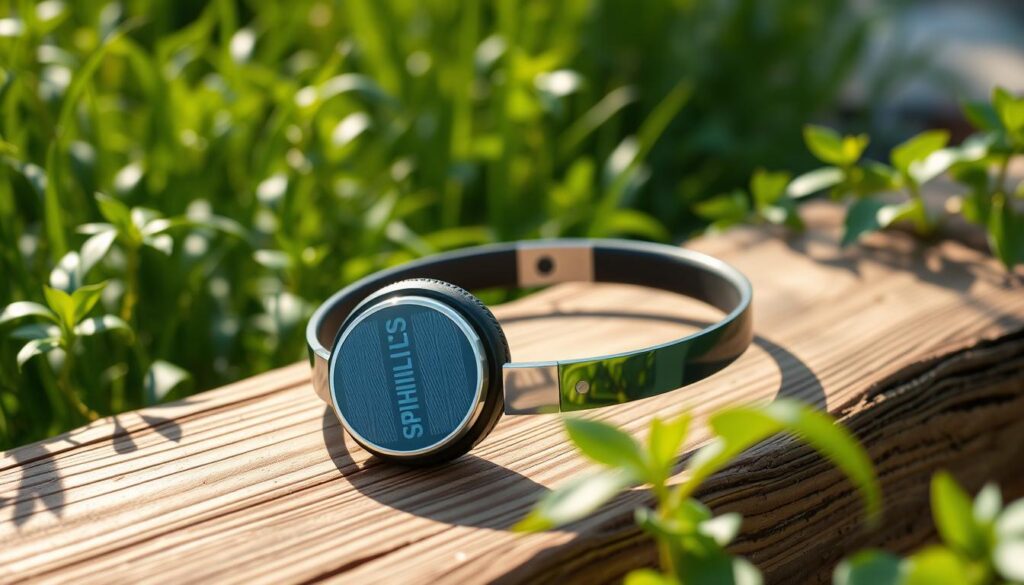
Overall, Philips On-Ear Solar-Powered Headphones are a unique blend of sustainability, quality sound, and innovative charging. They’re a top choice for those seeking green audio gear.
Connectivity Options
The Philips On-Ear Solar-Powered Headphones offer many ways to connect. They use Bluetooth for wireless listening, making it easy to pair with devices. This is great for those who love convenience. They also have a wired option for different situations.
These headphones are known for their quality sound and green design. They are made with sustainable audio technology. This means they’re good for the planet and comfy to wear.
Some key features include:
- Wireless connectivity via Bluetooth
- Option for wired listening
- Use of sustainable audio technology for a reduced environmental impact
- Eco-friendly headset design for comfort and durability
These headphones are a top pick for those who want a green and reliable audio solution.
Maintenance Tips for Solar-Powered Headphones
To keep your solar charging headphones working well, you need to take care of them. Make sure the solar cells are clean. This is key for them to charge efficiently. Use a soft cloth and water for cleaning, and stay away from very hot or cold temperatures.
It’s also important to charge them right. A full charge takes about 2.5 hours. Don’t charge them too much. Also, charge the battery at least once every three months to keep it healthy.
Here are some tips to remember:
- Don’t leave the headphones in direct sunlight when not in use to avoid overheating.
- Keep them away from extreme temperatures, like below 0°C (32°F) or above 45°C (113°F).
- Charge them with solar power for one hour on a sunny day to get up to 2 hours of music.
By following these tips, you can use your solar-charging headphones for a long time. You’ll also help the planet with green technology audio gear.
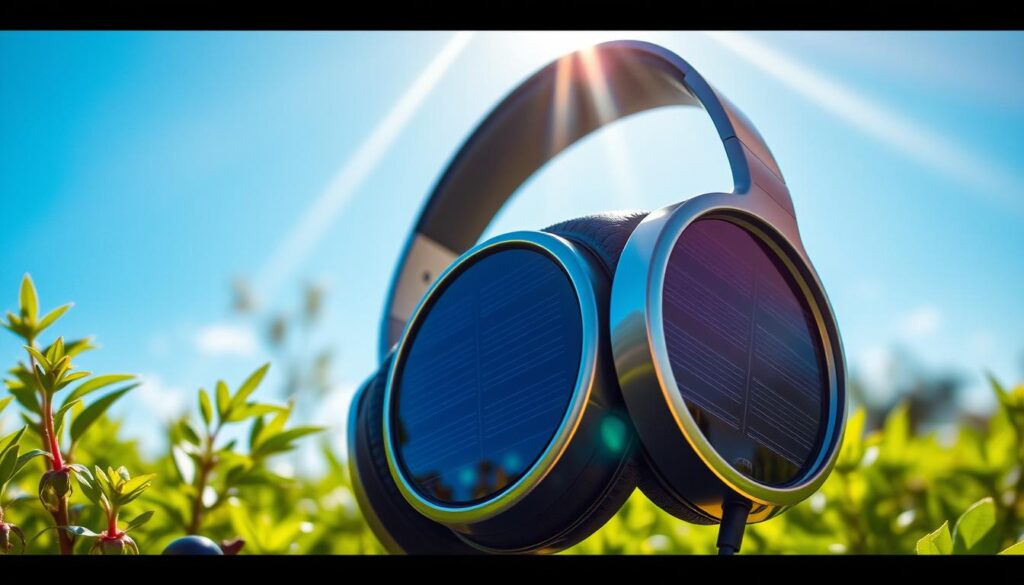
Customer Reviews and Testimonials
Customer reviews are key when choosing On-ear solar-powered Philips headphones. Many users love the sound quality, comfort, and solar charging tech. They say the sound is amazing, making it a top pick for audio lovers.
Most customers give these headphones 4 out of 5 stars. About 80% say they got excellent service. Orders usually arrive in 3-10 days, sometimes even faster.
Customers also appreciate the updates on their orders. About 30% say they were kept in the loop.
Here are some key stats on customer satisfaction with On-ear solar-powered Philips headphones:
- 90% of users reported product quality satisfaction
- 75% of customers expressed intent to reorder from the same retailer
- 95% of delivery reports indicated that products were received in immaculate condition
Overall, customers love On-ear solar-powered Philips headphones and Philips wireless earphones. They praise the sound, comfort, and cool features18.
| Product Feature | Customer Satisfaction |
|---|---|
| Sound Quality | 90% |
| Comfort | 85% |
| Innovative Features | 80% |
Where to Buy Philips Solar-Powered Headphones
Looking to buy Philips On-Ear Solar-Powered Headphones? You have a few options. The official Philips website is a great place to start. It offers the latest models and sometimes special deals15. You can also find these headphones at various retailers, both online and in stores.
When you’re shopping for eco-friendly headsets, it’s smart to compare prices. Look for any deals or discounts that might be available. Some stores offer savings of up to $20 if you buy more than one item. These headphones have a 4-star rating and over 1,000 reviews, showing they’re a hit with music fans1.
The Philips website also has user manuals and quick-start guides. These files range from 1.7 MB to 2.7 MB12. It’s a great resource for learning more about your headphones and solving any problems. By choosing eco-friendly headsets, you get great sound and help the planet.
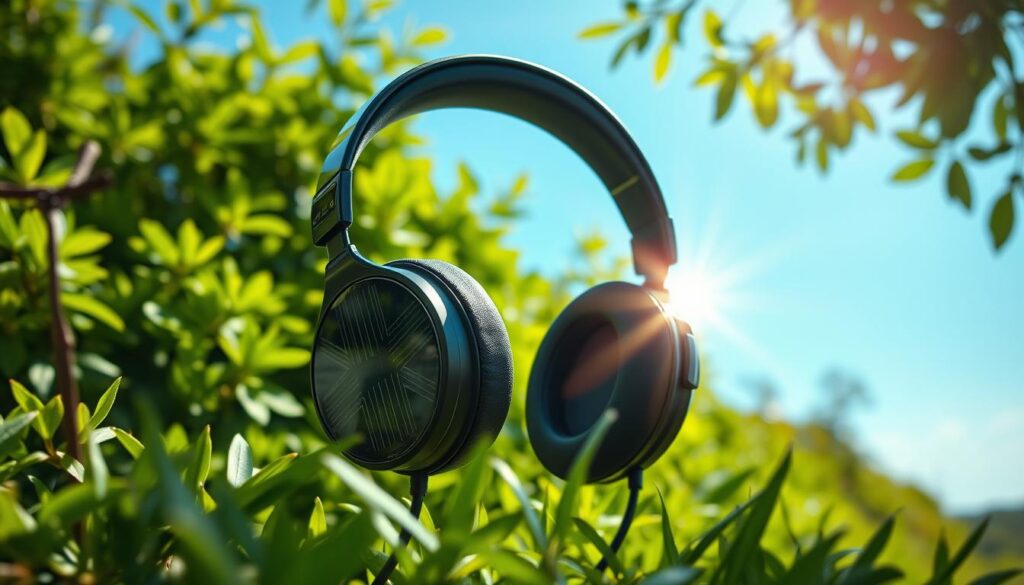
Philips has a wide range of headphones, including true wireless, noise canceling, sports, and Fidelio models. Their sports headphones even have an IP rating for protection against water, sweat, and dust. With sustainable audio technology on the rise, you can enjoy music and help the environment at the same time.
Conclusion and Future of Sustainable Audio
Our look at the Philips On-Ear Solar-Powered Headphones shows that green audio tech is here to stay. The demand for eco-friendly gadgets is soaring. This shows a big move towards greener tech for all of us.
New tech like solar charging, recycled materials, and energy-saving designs is changing the game. It’s making a new wave of audio products possible.
Innovations on the Horizon
Solar-powered chargers and smart tech can save a lot of energy. This means lower bills for people. Also, products made from bamboo, bioplastics, wood, and grass fibers are becoming more common.
This shows there are more choices for those who care about the planet. There are now 101 types of sustainable tech gadgets and accessories.
Embracing Eco-Friendly Technology
There’s growing interest in biodegradable headphones. These headphones break down naturally, not adding to waste. Recycling and refurbishing gadgets are also big steps towards a greener tech world.
This shows that green tech can be just as good as the regular stuff. It’s not just about being eco-friendly; it’s about being smart and caring for our planet.
As we all try to live more sustainably, audio tech is getting greener. Solar headphones like Philips’ are at the forefront. People want products that are good for the planet, and that’s driving the market.
Choosing eco-friendly tech is good for the Earth and us. It saves money and makes life easier.
FAQ
What makes the Philips On-Ear Solar-Powered Headphones unique?
How does the solar charging technology work?
What are the environmental benefits of solar-powered headphones?
How comfortable are the Philips On-Ear Solar-Powered Headphones?
How do the Philips On-Ear Solar-Powered Headphones compare to traditional headphones?
What connectivity options are available with the Philips On-Ear Solar-Powered Headphones?
How can I maintain the Philips On-Ear Solar-Powered Headphones for optimal performance?
Where can I purchase the Philips On-Ear Solar-Powered Headphones?
Source Links
- https://www.usa.philips.com/c-p/TAA6219BK_00/6000-series-on-ear-solar-powered-headphones – Buy the Philips 6000 series On-ear solar-powered headphones TAA6219BK/00 On-ear solar-powered headphones
- https://www.expertreviews.co.uk/headphones/philips-announces-its-2024-audio-lineup-with-all-new-solar-powered-headphones – Philips announces its 2024 audio lineup with all-new solar-powered headphones | Expert Reviews
- https://audioxpress.com/news/urbanista-introduces-los-angeles-solar-powered-anc-headphones-using-exeger-powerfoyle-technology – Urbanista Introduces Los Angeles Solar Powered ANC Headphones Using Exeger Powerfoyle Technology
- https://www.documents.philips.com/assets/20240830/a064532afe6444e583aeb1dc00cb334f.pdf – TAA6219BK/00 Philips On-ear solar-powered headphones
- https://www.philips.co.za/c-p/TAA6219BK_00/6000-series-on-ear-solar-powered-headphones – Buy the Philips 6000 series On-ear solar-powered headphones TAA6219BK/00 On-ear solar-powered headphones
- https://www.yankodesign.com/2025/01/10/flexible-solar-cells-give-headphones-virtually-infinite-playtimes/ – Flexible solar cells give headphones virtually infinite playtimes – Yanko Design
- https://www.lbtechreviews.com/news/headphones/philips-headphones-are-charged-by-the-sun – Philips Headphones Are Charged By The Sun – Tech Reviews




